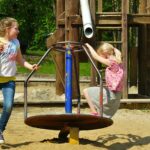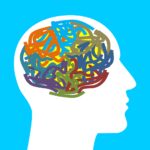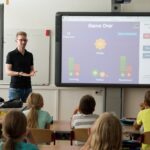Richard A. Faber
Richard Faber has been teaching at Syosset High School for the past 27 years. He obtained his BS in Physical Education and Health Certification from Ithaca College. His Masters and School District Administration Certificate is from Stony Brook University. Richard is also a certified Driver Education Instructor and he has been the Coordinator of Driver and Traffic Safety at Syosset since 1999. He is also the DASA Coordinator for the Syosset Central School District.
Richard teaches Peer Leadership at Syosset and he also teaches wellness classes. He has trained numerous teachers in Peer Mediation and Conflict Resolution and he has presented workshops on Character Education, Conflict Resolution, Student Engagement, to name a few across Long Island. Richard is no stranger to teacher education; he has been teaching in-service and graduate classes for the past 20 years. He looks forward to continue educating teachers in all of the different types of courses he offers.
Check out my course offerings:
Courses |
|---|
 The Dynamics of Conflict The Dynamics of ConflictIn a world where conflict is usually equated with violence, and therefore, fear is a common reaction, it is essential to underscore the opportunities presented by conflict. When violence emerges as a predominant aspect of conflict, these opportunities are lost. Conflicts emerge constantly from our perceptions of the commonplace events of everyday life, and demonstrate what each individual considers to be important and relevant to them. Thus, the elements for the peaceful settlement of a conflict are to be found in the conflict itself.
In this course, teachers will learn how to more effectively express and mange the value differences, tensions, and misunderstandings associated with conflict. At the same time, they will be able to teach their students how to acknowledge one another, and build understanding based on the real needs of those involved in the dispute.
Teachers will be guided on how to effectively establish a conflict resolution and peer- mediation program in their classroom as well as in their schools. All of the necessary skill training, practice, and resources will be provided.
Course Objectives
1. To help students define conflict and its connotations; identifies common societal messages about conflict; reviews the major kinds of conflicts we encounter.
Standard 2: A Safe and Healthy Environment
Students will acquire the knowledge and ability necessary to create and maintain a safe and healthy environment
2. To explore three basic approached to conflict, the effectiveness of each, and how they interact with each other.
Standard 2: A Safe and Healthy Environment
Students will acquire the knowledge and ability necessary to create and maintain a safe and healthy environment
3. To build skills to understand and manage anger and other strong emotions more effectively, exploring the important role emotions play in conflict.
Standard 2: A Safe and Healthy Environment
Students will acquire the knowledge and ability necessary to create and maintain a safe and healthy environment
4. To describe the communication process and the factors that influences it, and focus on the role of cultural differences in the communication process.
Standard 2: A Safe and Healthy Environment
Students will acquire the knowledge and ability necessary to create and maintain a safe and healthy environment
5. To help students put together effective listening and speaking skills for better interpersonal understanding; providing practice in a collaborative problem solving process.
Standard 2: A Safe and Healthy Environment
Students will acquire the knowledge and ability necessary to create and maintain a safe and healthy environment
ON-LINE (3 credits/45 hours) In-serice credit only $250.00$280.00 Buy here |
 The Effect That Stress has on Student Learning The Effect That Stress has on Student LearningThis course will describe the sources and con-sequences of stress. Stress is a common problem that will affect almost all of your students at some point in their lives. This course will help you to learn when to identify when a person is under stress, what causes stress, and different ways of coping with stress. Instructional strategies will be taught that can help students self-regulate such as reducing extraneous noise, managing transitions, and understanding mindsets, to name a few
ON-LINE (3 credits/45 hours) In-service credit only $250.00$280.00 Buy here |
 Effectively Utilizing Dialectical Journals in All Subjects Effectively Utilizing Dialectical Journals in All SubjectsEvery teacher has become a teacher of literacy. Impacting students’ abilities via journal usage creates learners with exceptional style and fortitude. Journal writing in all subject matters enriches the student and creates a sense of accomplishment and aptitude. In this course, teachers will utilize dialectical journals, reader’s journals, reader’s responses, written conversations. They will integrate aspects of their lives that promote advanced analysis, communication skills, descriptive, narrative, and persuasive writing techniques.
*A must for K-12 Educators!!!!
ON-LINE (3 credits/45 hours) In-service credit only $250.00$280.00 Buy here |
 Engaging the Disengaged Learner Engaging the Disengaged LearnerSchools experience a wide variety of crises that have the potential to harm the mental and physical health, learning environment, and safety of students and educators. A school crisis is any traumatic event that seriously disrupts coping and problem-solving abilities of students and school staff. It is typically sudden, unexpected, dramatic and forceful and may even threaten survival. A crisis can cause a drastic and tragic change to the environment. This change is generally overwhelming and uncontrollable as well as unwanted and frightening. It may create a sense of helplessness, hopelessness, and vulnerability combined with a loss of safety.
This course will provide resources, tools, recommendations, and evidence-based practices for incorporating best practices in school mental health into school crisis plans. Different types of crisis will be discussed and strategies will be developed for teachers of all grade levels and subject areas.
ON-LINE (3 credits/45 hours) In-service credit only $250.00$280.00 Buy here |
 Engaging the Disengaged Learner Engaging the Disengaged LearnerLearning is a lot like bike riding. Once you have the knack, you never really forget the skill. Nor do you forget the thrill of learning a new ability or understanding a complex idea. You are a lifelong learner and you love it.
Why have so many students never discovered this thrill? Why are they coasting when they could be racing along in the educational Tour de France with their peers? What can teachers do to engage the disengaged student?
This course will help teachers keep students highly engaged throughout an entire lesson and encourage students to contribute their ideas and insights as a way of enhancing their own and other students’ learning.
Learning Outcomes
At the completion of this course students will be able to:
1. Expect students to help define topics and determine how they can be studied
2. Link content to students’ prior knowledge and experience.
3. Ensure that students are mentally engaged in all activities and assignments
4. Allow students to initiate and adapt learning activities and projects.
5. Form instructional groups that work to achieve learning goals.
6. Choose suitable instructional materials for lessons and encourage students to select resources that will help them learn
7. Teach highly coherent, well-planned, and well-paced lessons that include time for student reflection
ON-LINE (3 credits/45 hours) In-service credit only $250.00$280.00 Buy here |
 The Impact of Labeling and Sterotypes on Education The Impact of Labeling and Sterotypes on EducationPreppy. Techie. Geek. Freak. Loser. Jock. These are just a few of the labels that students live with every day. And some labels are a lot nastier. Who hands out these labels? What role do labels play? Do they help or hurt? Do people sometimes like their labels, or do they always hate them? This course will examine the truth behind these labels and the impact that they have on student behavior and learning. Suitable all educators K-12.
COURSE OBJECTIVES AND LEARNING STANDARDS
1. To learn where labels come from
Standard 2: A Safe and Healthy Environment.
Students will acquire the knowledge and ability necessary to create and maintain a safe and healthy environment.
2. To understand the emotions that go along with labeling
Standard 2: A Safe and Healthy Environment.
Students will acquire the knowledge and ability necessary to create and maintain a safe and healthy environment.
3. To look at how to reduce the emotional effect of labeling
Standard 2: A Safe and Healthy Environment.
Students will acquire the knowledge and ability necessary to create and maintain a safe and healthy environment.
4. To create environments that foster feelings of appreciation and acceptance
Standard 2: A Safe and Healthy Environment.
Students will acquire the knowledge and ability necessary to create and maintain a safe and healthy environment.
ON-LINE 3 Credits [45 hours] Inservice Credit Only $250.00$280.00 Buy here |
 Innovative Practices In Education Innovative Practices In EducationThe course is designed to enhance the knowledge base for professionals in an era of school restructuring, technological innovation, and social change. Teachers and administrators will learn first-hand about innovative practices and recent research in the field. Topics include: student self-assessment, teacher reflection, cooperative learning, mentoring, the use of technology in schools, home-school communication, inclusion to support learning diversity, and the challenge of school restructuring. Areas covered are: Learning Theory, Curriculum Design, Classroom Atmosphere, and Instructional Strategies among others. This course also covers the dilemma children face who are experiencing difficulty in learning situations because of ethnic group frustrations in the community, problems of social adjustment, socio-economic inequities, and learning gaps. The role of the school in facilitating the program for children of various cultures to become valued members of the community is discussed. Activities, content, and materials are related to current and relevant frameworks and standards. Recommended for all instructors K – 12.
Course Purpose:
The direct aim of this course is to add to personal professionalism as an educator by becoming more attentive to current issues in schools today and by being informed of some of the choices available to empower teachers in their own classrooms, including theories, methods, strategies, techniques, and ways to differentiate instruction to further aid student achievement.
ON-LINE (3 Credits – 45 Hours) In-service Credit only $250.00$280.00 Buy here |
 Keeping Our Students and Schools Safe Keeping Our Students and Schools SafeSchool violence can be prevented. Research shows that prevention efforts – by teachers, administrators, parents, community members, and even students – can reduce violence and improve the overall school environment. No one factor in isolation causes school violence, so stopping school violence involves using multiple prevention strategies that address the many individual, relationship, community, and societal factors that influence the likelihood of violence. Prevention efforts should ultimately reduce risk factors and promote protective factors at these multiple levels of influence.
COURSE OBJECTIVES
At the conclusion of the class students will be able to:
● Create school wide prevention and intervention strategies.
● Develop emergency response planning.
● Develop school policies and understanding legal considerations.
● Create a positive school climate and culture.
● Implement ongoing staff development.
● Ensuring quality facilities and technology.
● Foster school/law enforcement partnerships.
● Institute links with mental health/social services.
● Foster family and community involvement.
ON-LINE (3 Credits – 45 Hours) In-service Credit only $250.00$280.00 Buy here |
 Peace in Our Time: Establishing A Conflict Resolution and Peer Mediation Program Peace in Our Time: Establishing A Conflict Resolution and Peer Mediation ProgramIn a world where conflict is usually equated with violence, and therefore, fear is a common reaction, it is essential to underscore the opportunities presented by conflict. When violence emerges as a predominant aspect of conflict, these opportunities are lost. Conflicts emerge constantly from our perceptions of the commonplace events of everyday life, and demonstrate what each individual considers to be important and relevant to them. Thus, the elements for the peaceful settlement of a conflict are to be found in the conflict itself.
In this course, teachers will learn how to more effectively express and mange the value differences, tensions, and misunderstandings associated with conflict. At the same time, they will be able to teach their students how to acknowledge one another, and build understanding based on the real needs of those involved in the dispute.
Teachers will be guided on how to effectively establish a conflict resolution and peer- mediation program in their classroom as well as in their schools. All of the necessary skill training, practice, and resources will be provided. Suitable all educators K – 12.
COURSE OBJECTIVES AND STANDARDS
1. To help students define conflict and its connotations; identifies common societal messages about conflict; reviews the major kinds of conflicts we encounter.
Standard 2: A Safe and Healthy Environment
Students will acquire the knowledge and ability necessary to create and maintain a safe and healthy environment
2. To explore three basic approached to conflict, the effectiveness of each, and how they interact with each other.
Standard 2: A Safe and Healthy Environment
Students will acquire the knowledge and ability necessary to create and maintain a safe and healthy environment
3. To build skills to understand and manage anger and other strong emotions more effectively, exploring the important role emotions play in conflict.
Standard 2: A Safe and Healthy Environment
Students will acquire the knowledge and ability necessary to create and maintain a safe and healthy environment
4. To describe the communication process and the factors that influences it, and focus on the role of cultural differences in the communication process.
Standard 2: A Safe and Healthy Environment
Students will acquire the knowledge and ability necessary to create and maintain a safe and healthy environment
5. To help students put together effective listening and speaking skills for better interpersonal understanding; providing practice in a collaborative problem solving process.
Standard 2: A Safe and Healthy Environment
Students will acquire the knowledge and ability necessary to create and maintain a safe and healthy environment
On-Line 3 Credits [45 hours] In-Service Credit only $250.00$280.00 Buy here |
 Restorative Justice Restorative JusticeEducators across the nation recognize the importance of fostering positive, healthy school climates and helping students learn from their mistakes. Increasingly, they are partnering with parents, students, district officials, community organizations, and policymakers to move away from harmful and counter-productive zero-tolerance discipline policies and toward proven restorative approaches to addressing conflict in schools.
Restorative practices is an emerging social science that studies how to strengthen relationships between individuals as well as social connections within communities. Restorative justice also promotes a positive, orderly school environment. Students and all members of the school community can learn and practice self-discipline, empathy, and accountability.
Course Objectives
At the conclusion of the class students will be able to:
• Foster understanding and develop empathy
• Actively involve and attend to the needs of all parties
• Encourage accountability and responsibility
• Reintegrate all parties into the community as a valuable, contributing member
• Seek to repair the harm
Teaching/Learning Strategies
Participants:
• Will get to know one another via “getting to know you” activities
• Will learn what is expected of them – (course requirements)
• Will use active learning strategies with instructor facilitation
• Engage in journal writing and reflection, news forums
• Perform in-depth case studies and problem-solving scenarios
• Learning will focus on student-centered rather than teacher-centered
• Will have the opportunity to visit outside resources
On-Line (3 Credits/45 hours) In-Service Credit only $250.00$280.00 Buy here |
